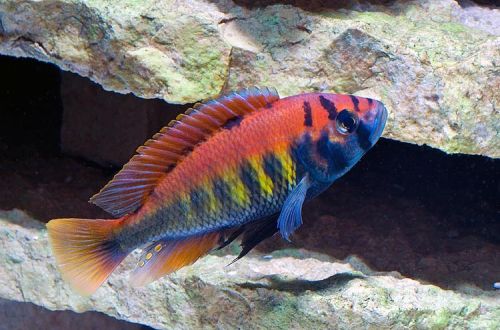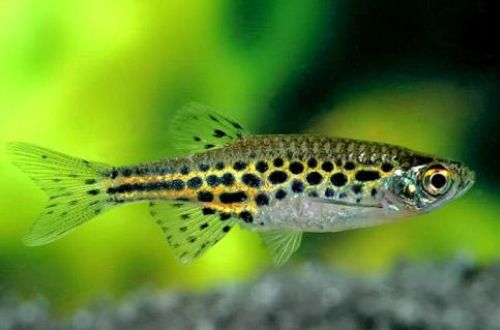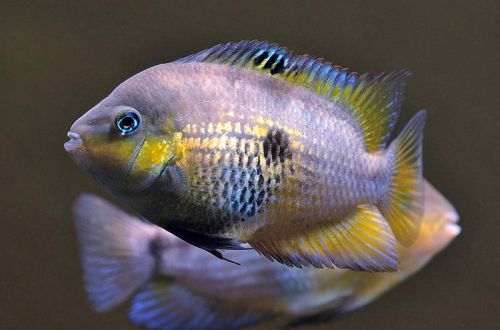
Butterfly barbus
Butterfly barb or Moth barb, scientific name Barbus hulstaerti, belongs to the Cyprinidae family. A beautiful and easy to keep fish, but rare on sale. Deliveries resumed only in 2006, after a 25-year break caused by epidemics in the Democratic Republic of the Congo, the only habitat of this species.
Contents
Habitat
It comes from the African continent from a limited area in the north of the Democratic Republic of the Congo from the Mongala River basin, the right tributary of the Congo River. It inhabits small streams and rivers flowing under the canopy of the tropical forest, as well as swamps. The natural habitat is characterized by an abundance of aquatic plants, the bottom is littered with fallen, decaying vegetation, releasing tannins, which in turn give the water a brown color.
Brief information:
- The volume of the aquarium – from 40 liters.
- Temperature – 17-24°C
- Value pH — 5.0–6.5
- Water hardness – 1–5 dGH
- Substrate type – any soft
- Lighting is weak
- Brackish water – no
- Water movement is weak
- The size of the fish is about 3 cm.
- Feeding – any food of suitable size
- Temperament – peaceful
- Keeping in a group of 8-10 individuals
Description
Adults reach a length of about 3 cm. The color is silver-pink, the fins are yellow. The body pattern consists of several large dark spots. Sexual dimorphism is weakly expressed, males and females are almost indistinguishable.
Food
Omnivorous species, accepts most popular foods (dry, frozen, live) of a suitable size. When choosing food, give preference to well-known and trusted manufacturers, since the quality of the products directly affects the health of the fish.
Maintenance and care, arrangement of the aquarium
The optimal size of the aquarium for a small flock of Butterfly Barbs starts from 40 liters. The design uses sandy soil, several shelters in the form of snags and dense clusters of shade-loving aquatic plants, including floating ones, or their artificial counterparts. The lighting is subdued. Dry leaves of trees submerged to the bottom can give naturalness to the design. They will not only decorate the aquarium, but also give the water a “tea” shade inherent in the habitats of this species of fish. Read more in the article “Which tree leaves can be used in an aquarium.”
Successful management is largely dependent on maintaining stable water conditions and following a few standard maintenance procedures: weekly water changes to fresh water, removal of organic waste (feed leftovers, excrement), equipment maintenance, monitoring of pH / dGH / oxidizability parameters.
Behavior and Compatibility
Peaceful mobile fish, compatible with other species of comparable size. Accordingly, the introduction of large and even more aggressive fish that can intimidate or eat Moth Barbs should be avoided.
It is recommended to purchase a group of at least 8-10 individuals. Intraspecific relationships are built on the dominance of the alpha male. Subdominant males can sometimes hide from excessive attention, so the presence of hiding places is vital.
Breeding / breeding
The breeding season occurs twice a year, from March to June and from September to November. Despite the long-term maintenance of this species in the artificial environment of aquariums, seasonality has been preserved. With the onset of the mating season, the females scatter the eggs in the water column, and the dominant male (sometimes there may be several) fertilize them. Parental instincts are not developed, but unlike other Barbs, adult fish are not inclined to eat their eggs and juveniles, although this is possible on occasion. The incubation period lasts up to 10 days. After another 2-3 days, the fry begin to swim freely in search of food.
It is worth noting that although the risks of being eaten by their own parents are low, the survival rate of Barb Butterfly fry will still be quite low. The main reasons are the threat from other species (if any) and the lack of food, since the juveniles cannot compete for food, and even if they manage to get to it, the food particles themselves will be too large for them.
An effective way to increase the survival of fry is a spawning aquarium, where eggs are placed at the end of spawning or fry that have already appeared. As a spawning aquarium, a small tank with a volume of 10 liters or more with identical water conditions is suitable. The set of equipment usually includes a simple airlift filter with a sponge and a heater. A separate light source is not required, a low level of illumination is only welcome. Arrangement is optional. Feed with specialized food for juvenile aquarium fish and/or brine shrimp nauplii.
Fish diseases
In a balanced aquarium ecosystem with species-specific conditions, diseases rarely occur. Diseases are caused by environmental degradation, contact with sick fish, and injuries. If this could not be avoided, then more about the symptoms and methods of treatment in the section “Diseases of aquarium fish”.





